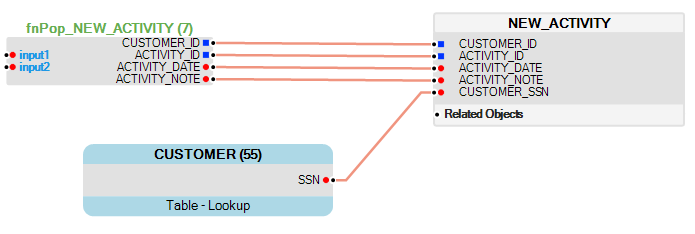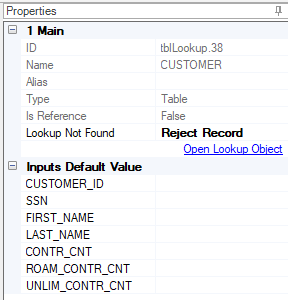Lookup Tables
A Lookup table is an object that is added to a Table Population to get information from a source DB table, LU table or Reference table. A lookup returns one record for each input record. The matching SQL query is generated for a Lookup table by Fabric:
- Input fields are used for the WHERE clause of an SQL statement.
- Output fields are used for the SELECT statement of an SQL statement.
The input in a Lookup table is optional if the Lookup has only one record. For example, when a Lookup is created based on the Customer LU table and the Customer is the Root Table of the LU. In this case the Customer LU table will only have one record.
How Can I Add a New Lookup To a Table Population?
Go to Project Tree > Logical Units > [LU Name].
Click Tables > [Table Name] > [Table Population].
Click the Objects tab in the right panel of the Table Population working area.
Do either:
- To create an LUI Table Lookup or Reference Table Lookup:
Click LUI Tables Lookup / Reference Tables Lookup to display the list of tables, select the table and drag it to the working area. - To create a Database Table Lookup:
Click Database to display the list of tables, select the table and drag it to the working area and then click Create as DB Table Lookup.
- To create an LUI Table Lookup or Reference Table Lookup:
Connect the Lookup’s Input and Output fields to the table columns.
- Optional: connect the Lookup Input fields to the Source Table.
- Connect the Lookup Output fields to the Target.

Right click the Lookup and select Minimize to display only the Lookup’s connected fields.
In the Properties Tab (right panel of the Table Population working area), click the dropdown list and select the action for when a Lookup Value is not found.
Notes
- It is recommended to create a Lookup based on an LU table and not a DB table in order to improve performance. The reason is that an LU table is usually much smaller than the source DB table, since it includes only the data which is relevant / applicable for an LU. In addition, the LU table is kept in the Fabric memory and is faster to retrieve.
- It is recommended to create an index on the LU table for the Input fields in order to improve performance of the Lookup table’s Search.
- When creating a Lookup based on an LU table, check that the Lookup object is populated before the current table. Which means that the table has a higher execution order than the Lookup object.
Lookup Properties Tab

The following information is displayed in the Lookup Properties:
|
Main |
Non-editable fields:
|
|
Lookup Not Found |
Dropdown list of Fabric actions when the Lookup value is not found:
|
|
Misc. |
Non-editable fields, applicable only for source DB table lookups:
|
|
Open Lookup Object |
Link to open the Table Schema window. |
|
Inputs Default value |
User-defined default values for each Input field in the Lookup. Used when there is no link connected to the field or when a Null value is received. |
Lookup Tables
A Lookup table is an object that is added to a Table Population to get information from a source DB table, LU table or Reference table. A lookup returns one record for each input record. The matching SQL query is generated for a Lookup table by Fabric:
- Input fields are used for the WHERE clause of an SQL statement.
- Output fields are used for the SELECT statement of an SQL statement.
The input in a Lookup table is optional if the Lookup has only one record. For example, when a Lookup is created based on the Customer LU table and the Customer is the Root Table of the LU. In this case the Customer LU table will only have one record.
How Can I Add a New Lookup To a Table Population?
Go to Project Tree > Logical Units > [LU Name].
Click Tables > [Table Name] > [Table Population].
Click the Objects tab in the right panel of the Table Population working area.
Do either:
- To create an LUI Table Lookup or Reference Table Lookup:
Click LUI Tables Lookup / Reference Tables Lookup to display the list of tables, select the table and drag it to the working area. - To create a Database Table Lookup:
Click Database to display the list of tables, select the table and drag it to the working area and then click Create as DB Table Lookup.
- To create an LUI Table Lookup or Reference Table Lookup:
Connect the Lookup’s Input and Output fields to the table columns.
- Optional: connect the Lookup Input fields to the Source Table.
- Connect the Lookup Output fields to the Target.

Right click the Lookup and select Minimize to display only the Lookup’s connected fields.
In the Properties Tab (right panel of the Table Population working area), click the dropdown list and select the action for when a Lookup Value is not found.
Notes
- It is recommended to create a Lookup based on an LU table and not a DB table in order to improve performance. The reason is that an LU table is usually much smaller than the source DB table, since it includes only the data which is relevant / applicable for an LU. In addition, the LU table is kept in the Fabric memory and is faster to retrieve.
- It is recommended to create an index on the LU table for the Input fields in order to improve performance of the Lookup table’s Search.
- When creating a Lookup based on an LU table, check that the Lookup object is populated before the current table. Which means that the table has a higher execution order than the Lookup object.
Lookup Properties Tab

The following information is displayed in the Lookup Properties:
|
Main |
Non-editable fields:
|
|
Lookup Not Found |
Dropdown list of Fabric actions when the Lookup value is not found:
|
|
Misc. |
Non-editable fields, applicable only for source DB table lookups:
|
|
Open Lookup Object |
Link to open the Table Schema window. |
|
Inputs Default value |
User-defined default values for each Input field in the Lookup. Used when there is no link connected to the field or when a Null value is received. |





